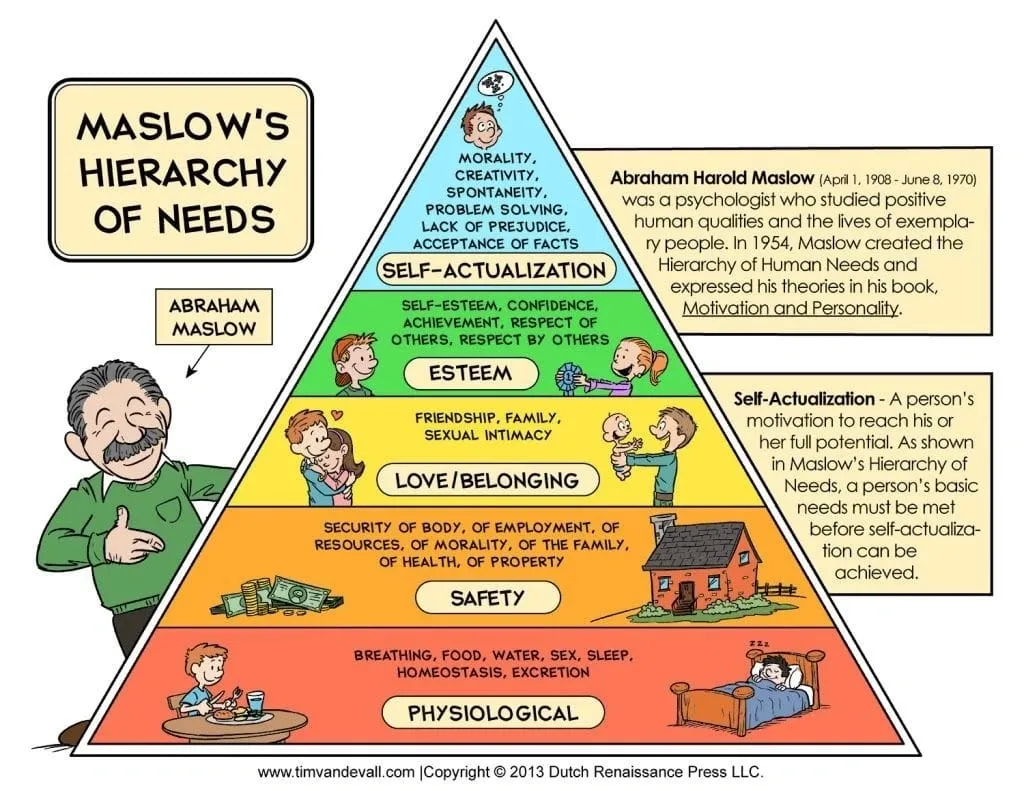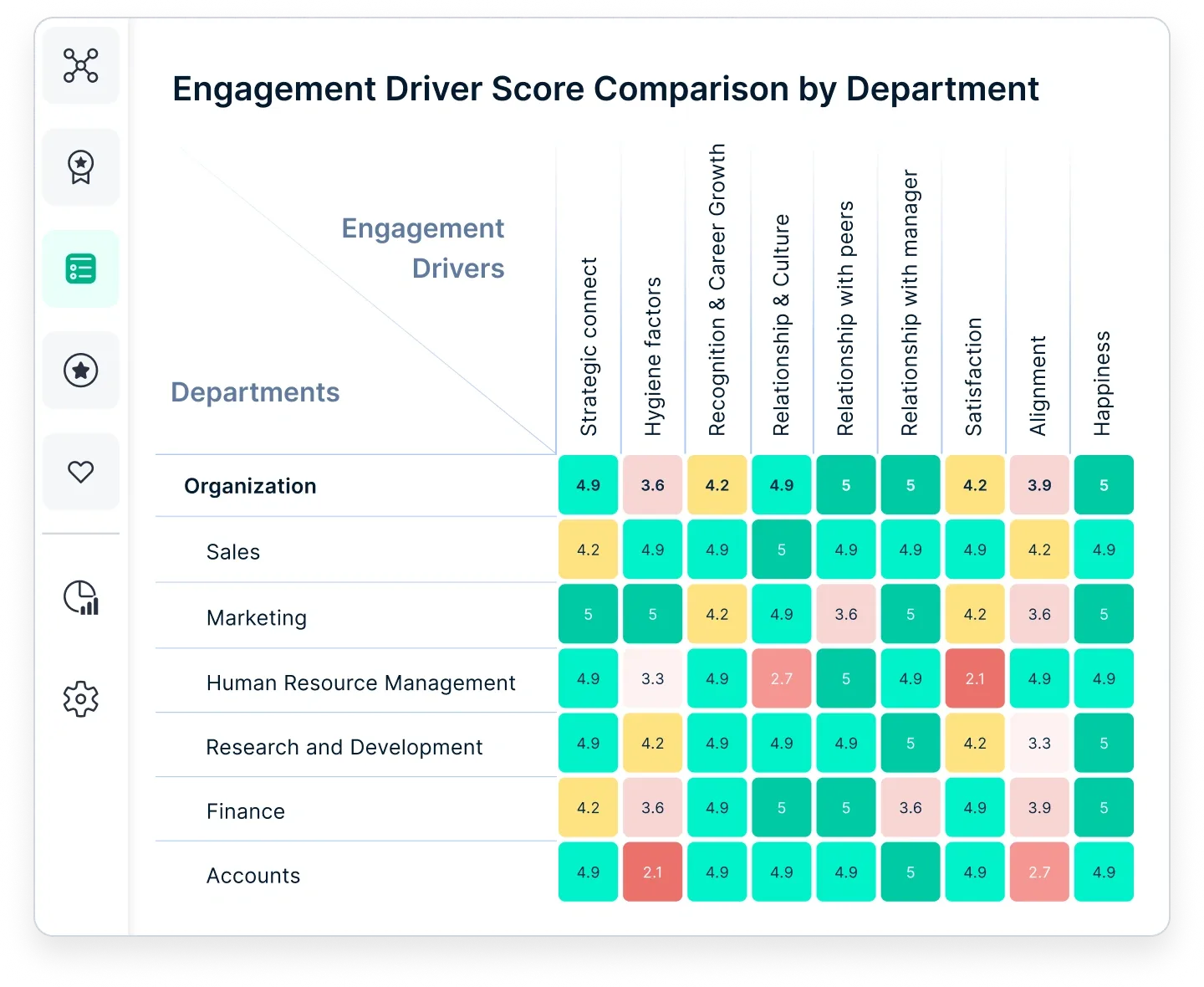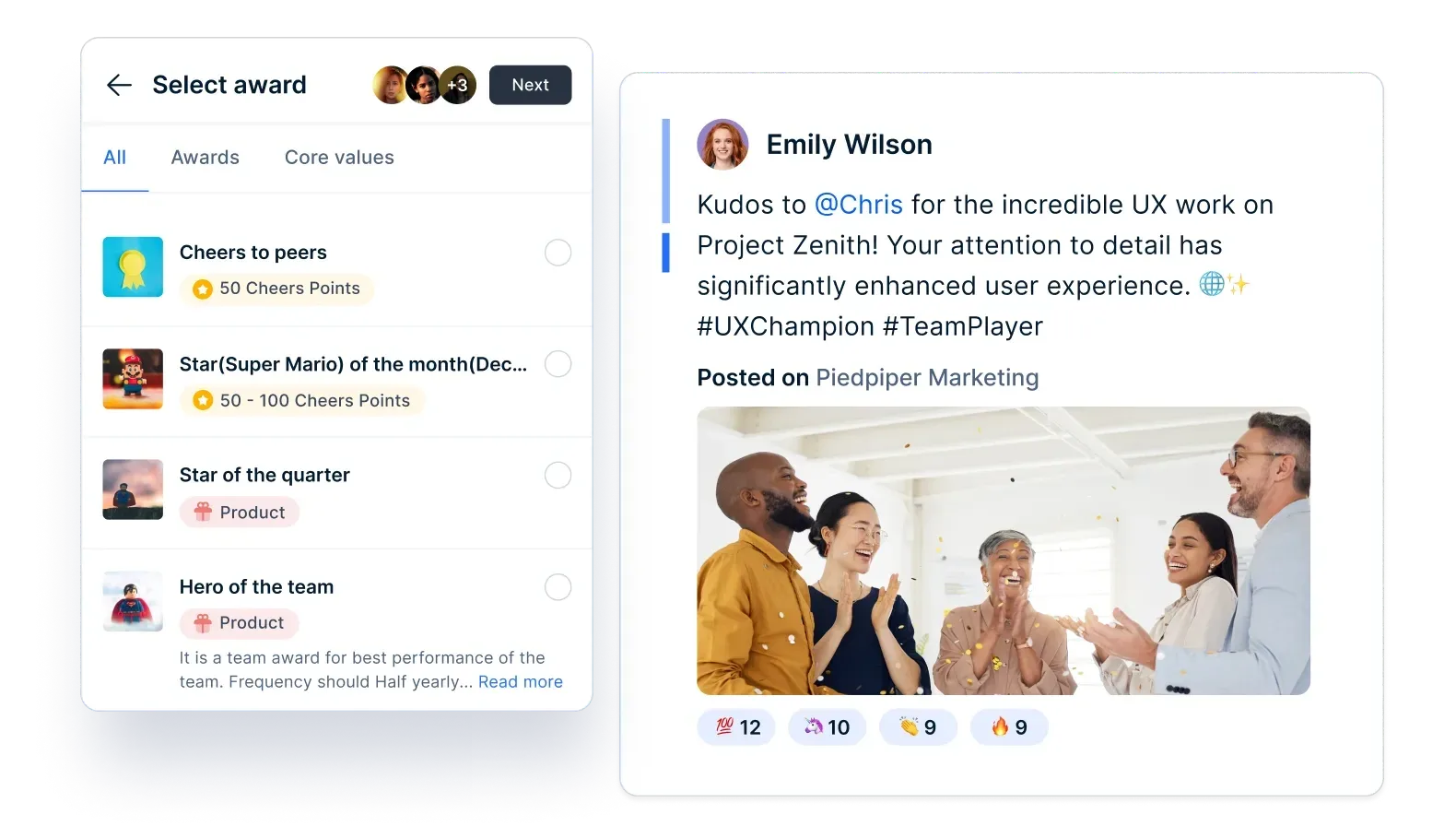11 Proven Employee Engagement Strategies to Boost Productivity in 2025
Explore 11 powerful employee engagement strategies to enhance productivity, boost morale, and retain top talent. Create a motivated workforce with these actionable insights.
In questa pagina
- Comprendere il coinvolgimento dei dipendenti
- I vantaggi di una forza lavoro altamente coinvolta
- Types of employee engagement techniques
- 11 Employee engagement strategies you must implement in 2025 to boost productivity
- 5 Common employee engagement mistakes to avoid
- Strumenti essenziali per valutare il coinvolgimento dei dipendenti
- Conclusione
- Domande frequenti
As per a report a staggering $8.9 trillion (about $27,000 per person in the US) is drained from the global economy due to low employee engagement—imagine the transformative impact of unleashing this untapped potential with the correct employee engagement strategies.
Il coinvolgimento dei dipendenti è più di una parola d'ordine: è la forza trainante del successo organizzativo. Immaginate un luogo di lavoro in cui i dipendenti non si limitano a timbrare il cartellino, ma sono realmente investiti, motivati e appassionati del proprio ruolo.
Questo livello di coinvolgimento non avviene per caso, ma richiede strategie intenzionali e una profonda comprensione di ciò che motiva veramente la vostra forza lavoro. In un panorama aziendale competitivo come quello odierno, in cui il costo del disimpegno si misura in miliardi, assicurarsi che i dipendenti si sentano apprezzati e coinvolti non è solo importante, è essenziale.
This blog will share a few simple employee engagement strategies that every team member expects from their leader, and if you provide them, then even in today’s fast-paced, ever-changing, highly mobile, and distributed world, they will work to help create highly engaged teams.
Comprendere il coinvolgimento dei dipendenti
Il coinvolgimento dei dipendenti è un fattore critico per il successo delle organizzazioni. È molto più importante della semplice soddisfazione lavorativa: si tratta di creare un ambiente di lavoro altamente produttivo e motivato. Comprendere le componenti e i benefici del coinvolgimento dei dipendenti è il primo passo per sviluppare strategie efficaci che favoriscano una forza lavoro altamente coinvolta.
As per an article by Forbes, employees tend to leave an organization when they feel ignored or overlooked. Keeping this in mind, let’s have a look at the various aspects of employee engagement and learn management techniques for employee engagement in contemporary organizations.
Le tecniche di coinvolgimento dei dipendenti ruotano attorno a diverse componenti chiave: impegno emotivo, soddisfazione sul lavoro e senso dello scopo. I dipendenti che si impegnano emotivamente nell'organizzazione sono più propensi a fare sforzi discrezionali, a fare il passo più lungo della gamba e a rimanere fedeli all'azienda.
This sense of purpose, when aligned with the company’s mission and values, forms the foundation of a highly engaged workforce. There are three primary types of employee engagement based on employee attitudes and performance:
- Actively engaged: Employees who are passionate about their work and dedicated to the company's goals. They spread positivity and serve as brand advocates.
- Not engaged: Employees who only complete required tasks, show little interest in the company, and lack proactivity.
- Actively disengaged: Unhappy employees who underperform spread negativity, and discourage others. They are the least engaged.
I vantaggi di una forza lavoro altamente coinvolta
Una forza lavoro altamente coinvolta è una risorsa potente per qualsiasi organizzazione. I dipendenti impegnati sono più produttivi, presentano livelli più elevati di innovazione e contribuiscono a migliorare le prestazioni aziendali complessive.
Inoltre, le aziende con un elevato coinvolgimento dei dipendenti tendono a registrare tassi di turnover più bassi, una maggiore soddisfazione dei clienti e una migliore redditività. Investire nel coinvolgimento dei dipendenti significa quindi investire nel successo futuro della vostra organizzazione.
As per an article by Indeed, employee engagement tools and techniques lead to an increase in employee retention, increase in customer satisfaction, contribution to innovation, and enhanced company culture.
The research was conducted by Harvard Business Review, wherein a total of 568 individuals participated in the survey, all of whom were employed by organizations with 500 or more employees. Over 42 percent of these respondents came from companies with 10,000 or more employees.
The survey had a global reach, with companies headquartered in North America (54 percent), Asia (18 percent), Europe (16 percent), the Middle East and Africa (7 percent), and South/Central America (5 percent).
Respondents represented a diverse range of industries: 16 percent were in IT/telecommunications, 14 percent in financial services, 12 percent in manufacturing, 9 percent in energy/utilities, 8 percent in healthcare, 8 percent in education, and the remaining 33 percent were from various other sectors.
Seventy-one percent of respondents consider employee engagement to be crucial for overall organizational success. Additionally, seventy-two percent believe that recognizing high performers has a significant effect on employee engagement. However, only twenty-four percent of respondents feel that employees in their organization are highly engaged.
Employee engagement has surged to the forefront of business priorities for senior executives. In today’s fast-paced economy, leaders understand that fostering a high-performing workforce is crucial for both growth and survival.
They acknowledge that a highly engaged team can drive innovation, boost productivity, and enhance financial performance, while also cutting costs associated with hiring and retention in a competitive talent market. Despite this awareness, many executives struggle to find effective ways to measure and address engagement.
However, a growing number of leading companies are gaining a competitive edge by implementing metrics and practices that quantify and enhance the impact of their engagement strategies on overall business outcomes.
The research reveals a disconnect between executive optimism and middle management’s perception of employee engagement. While top executives are generally more positive about engagement levels, three-quarters of those surveyed reported that most employees are not highly engaged, pointing to a significant gap in understanding between executive and middle management perspectives.
Moreover, many companies face challenges in measuring engagement and linking it to financial performance, with fewer than 50 percent effectively correlating employee engagement with metrics such as customer satisfaction or market share.
Yet, a group of companies identified as “high prioritizers” have successfully employed metrics and shared best practices to connect engagement efforts with business performance.
Types of employee engagement techniques
Per promuovere il coinvolgimento, le organizzazioni devono implementare una serie di tecniche adatte alla loro cultura e alle esigenze dei dipendenti. Ecco alcune strategie collaudate:
1. Regular feedback and recognition: Employees need to know how they’re doing and that their efforts are recognized. Regular feedback—both positive and constructive—helps employees improve and stay aligned with organizational goals. Recognition programs, whether formal or informal, show appreciation for employees’ hard work and achievements, boosting morale and motivation.
2. Professional development opportunities: Providing opportunities for learning and growth is key to keeping employees engaged. When employees see a clear path for career advancement, they are more likely to stay motivated and committed. Offering training programs, mentorship, and career development resources can help employees build new skills and advance within the organization.
3. Work-life balance initiatives: Maintaining a healthy work-life balance is essential for employee well-being and engagement. Organizations can support this by offering flexible work arrangements, promoting the use of paid time off, and providing wellness programs. When employees feel their personal and professional lives are in harmony, they are more likely to remain engaged and productive.
4. Employee involvement in decision-making: Giving employees a voice in decision-making processes empowers them and fosters a sense of ownership and responsibility. Involving employees in discussions about company policies, projects, and goals not only leads to better outcomes but also strengthens their commitment to the organization.
11 Employee engagement strategies you must implement in 2025 to boost productivity
These strategies aren’t just ideas on paper—they’re practical ways to create a workplace where people feel connected, valued, and inspired to do their best work. Use these employee engagement strategies to retain your top performers and make them more productive.
1. Clear Direction: Catalyst to a successful employee engagement strategy
The first thing we need to do is to give people a clear direction. If you do not know what the goal and objects of the tasks are, then people can't be able to connect with them. When people lack clarity and direction, it’s difficult for them to become engaged, if not impossible. We should also look to clarify not only what we are doing but also why it is important and if we can explain why, it is important to them, then that’s even better.
As part of the program we were running at Fujitsu, we were moving a client to a new IT platform, so we looked to highlight to the team that they would be the first in the company to gain skills within this new technology which would help give them a competitive advantage and put them in demand for future projects.
2. Creating a safe environment
Nothing kills an effective employee engagement strategy faster than having a blame culture. I see this time and time again where people are criticized for mistakes, and demeaned in front of others for any tiny mishap.
This is a morale killer, it not only stops people from taking risks, but they also look to keep out of the firing line and do the minimum that is required of them, and if it gets too toxic, then they become disengaged completely.
Good leaders create a safe environment where people don’t feel afraid of making mistakes because that fear can lead to hesitation and mistakes. If mistakes happen, then focus on finding solutions, not who’s to blame, and give any feedback in a supportive way that will help people improve rather than highlighting their shortcomings, and also do it in private. Public autopsies of individual failure only make people warier of mistakes.
3. Set them up for success
Ever heard the phrase, “Success has a thousand fathers, but failure is an orphan child” this is one of my favorite sayings because it shows that everyone wants to be part of a winning team.
We all want to feel that we have achieved something, to experience success, and to get rewards and recognition. We are hard-wired for this, one of our basic needs is to have good self-esteem and a little bit of success serves to fill that need.
So, if we can show our teams how to be successful, if we give them the tools, they need to be successful, then not only will they become engaged, but they will become excited to be involved.
Le persone non hanno paura di lavorare sodo, ma di fallire e quando noi, in qualità di leader, riusciamo a dare loro la certezza di avere successo, allora, secondo la mia esperienza, lavoreranno sodo per ottenerlo.
4. Give them space to be successful
Whilst I believe that blame is one of the worst things for killing engagement, I must admit that Micro-Management is a very close second. Even with distributed teams, I have seen people become disengaged by managers constantly chasing them up through chats, emails, and phone calls.
It sometimes feels that Micro Managers see virtual teams and people 1000 miles away from them as some challenge and look for new and better ways to keep a close eye on them. Even though we might be working at home, it feels like Big Brother is still watching you.
Non fatelo!
Lasciate spazio al vostro team e date loro la possibilità di fare progressi prima di fare un controllo. Idealmente, concordate con loro quando sarebbe il momento giusto per tornare a vedere come stanno andando le cose.
Quando date spazio alle persone, dimostrate che vi fidate di loro; si sentiranno rispettate e questi sono due sentimenti che contribuiscono al coinvolgimento.
Questo non significa che non si debba mai fare il check-in, ma che bisogna farlo nei momenti giusti e, idealmente, in orari concordati. Questo non solo aiuterà il coinvolgimento, ma anche la responsabilizzazione.
5. Give them support when needed
Quando si tratta di far sentire alle persone che avranno successo, uno degli strumenti più potenti è far sapere loro che hanno il nostro sostegno e che possono rivolgersi a noi se necessario. È come dare a un trapezista una rete di sicurezza: probabilmente non la userà, ma sapere che c'è contribuirà ad accrescere la sua fiducia, aumentando ulteriormente il coinvolgimento.
89% of workers at companies that support well-being initiatives are more likely to recommend their company as a good place to work-American Psychological Association
We should let them know at the start that they can reach out if there are any difficulties or things they are unsure of or need a little help with. This also contributes to creating a safe environment, one where they know that if they start to have issues, not only will they not be blamed or criticized but one where they can get some help.
6. Give them good feedback
Con team altamente distribuiti, dobbiamo assicurarci che i canali di comunicazione siano chiari, aperti e utilizzati regolarmente. Dobbiamo organizzare chiamate periodiche per condividere i progressi con i team, quando possono vedere che stanno avendo successo: è una grande motivazione e dimostra che i loro sforzi stanno avendo successo. Inoltre, offre l'opportunità di fornire supporto quando è necessario apportare modifiche se le cose non vanno bene.
Employees feel 5x more empowered if their feedback is valued in the organization. - Salesforce
Dobbiamo anche lodare le persone per i loro sforzi e per i loro buoni progressi. Se le persone si impegnano ma non ricevono alcun feedback, possono cadere rapidamente nella mentalità del "non so perché mi preoccupo" e, quando ciò accade, iniziano a percorrere la strada del disimpegno.
Il feedback positivo non costa nulla, ma il ritorno sull'investimento è significativo: datelo liberamente.
Mentre il mondo cambia sempre di più, queste semplici cose vi aiuteranno a creare team impegnati. Funzioneranno con i team che riportano direttamente a voi; funzioneranno anche con i fornitori e il personale esterno, perché contribuiscono a soddisfare alcuni dei nostri bisogni fondamentali. Quanto meglio riuscirete a fare queste cose, tanto più i vostri team saranno impegnati e i risultati che otterrete saranno migliori.
7. Tour of duty
Le aziende di tutte le dimensioni, grandi o piccole, hanno spesso un approccio reattivo quando si tratta di fidelizzare e coinvolgere i dipendenti. Assumono nuove competenze e licenziano i dipendenti per risparmiare sui costi.
L'approccio sembra legittimo, serve alle esigenze aziendali nel breve periodo, ma diventa controproducente nel lungo periodo. I dipendenti traggono spunto da questi accordi. Si comportano come agenti liberi e saltano il lavoro ogni volta che si presenta una nuova opportunità.
Reid Hoffman, founder of LinkedIn proposes an adaptive approach in one of his books The Alliance: Managing Talent in the Networked Age. The approach is called ‘the tour of duty’.
The concept comes from the military where officers work on a single assignment or deployment and then move on to the next, defining their entire military career. This helps them grow their skills and experience and avoid reaching an unexpected plateau in their careers. They get to know the entire organization rather than feeling stuck in a single role for years. The organization also gets to develop the talent from an internal pool of employees and solve their succession problems.
Nell'approccio del "tour of duty", l'azienda e il dipendente concordano i risultati e le aspettative reciproche, nonché la tempistica del tour. Al termine di un tour, il dipendente può scegliere di intraprendere un altro tour di servizio all'interno dell'azienda, invece di sceglierne uno con un concorrente.
Non è controintuitivo incoraggiare i dipendenti a cercare nuovi incarichi? Il mondo delle start-up ha dimostrato che incoraggiare i dipendenti all'imprenditorialità fa sì che essi rimangano profondamente coinvolti.
Se l'azienda non offre un altro turno di lavoro, se ne andranno? Sì! Ma mantenere questi dipendenti anche per un periodo relativamente breve può fornire enormi vantaggi all'azienda e, naturalmente, è una strategia di coinvolgimento dei dipendenti unica nel suo genere.
In che modo il "tour of duty" è diverso dal normale "assumere, verificare le prestazioni, continuare o lasciare andare"? Nel caso del "tour of duty", è ampiamente chiaro che l'accordo è destinato a finire. La promessa fatta al dipendente non è solo uno stipendio, ma un aumento della sua occupabilità.
The duration is pre-decided, and it is usually kept at two years. There is no fuzzy expectation of “being a good employee” and no fuzzy commitment to the employee. Time-limited mutual commitment with clear goals and expectations is the hallmark of ‘tour of duty’. This may seem transactional but is better than buying time for money and driving employee retention via vague notions of loyalty.
8. Alumni networks and employee peer networks
Some of the leading technology companies such as Intuit actively run alumni networks. The benefit is obvious - tap into the network intelligence. At one end, such initiatives enable HR to tap back into the past talent for a rehire or get recommendations on new hires. However, more importantly, companies stand to benefit from the knowledge and information with people outside the company.
La saggezza tradizionale potrebbe suggerire di allontanare i dipendenti del passato, di firmare contratti rigidi e di trattare gli esistenti come se fossero permanenti. Tuttavia, ancora una volta, le lezioni delle start-up e di alcune organizzazioni lungimiranti hanno dimostrato qualcosa di nuovo. È molto più gratificante coinvolgere i dipendenti, gli ex-alunni e le reti di dipendenti piuttosto che evitarli senza mantenere un'eccessiva apprensione.
Costruite e attivate la rete dei vostri dipendenti. Insegnate loro come cercare e raggiungere tali reti. Informate i vostri dipendenti sulle informazioni non pubbliche e su quelle proprietarie. Queste ultime sono riservate e non devono uscire dalle mura dell'azienda.
D'altra parte, le informazioni non pubbliche sono quelle che possono scambiare e ricercare, come le nuove tendenze che osservano nel settore, i cambiamenti nella tecnologia, ecc. Incoraggiateli a spendere i pasti con persone esterne e a condividere in cambio le loro conoscenze all'interno dell'azienda.
Create una rete di alumni su LinkedIn, organizzate eventi importanti presso la sede dell'azienda, invitate influencer a parlare, offrite biglietti gratuiti ai vostri alumni e ai loro ospiti. Cogliete ogni occasione per costruire relazioni.
Se non avete risorse sufficienti per realizzare programmi così elaborati, fate semplicemente un giro di tavolo e chiedete le nuove informazioni che il team ha trovato di recente. E in cambio, offrite semplicemente un sentito apprezzamento per la condivisione di queste informazioni che potrebbero aver raccolto da ex alunni o dalla loro stessa rete. Alla fine, i dipendenti inizieranno a riconoscere le reti e a gestirle attivamente.
9. Employee well-being support mechanisms
Che vi piaccia o meno, che vogliate riconoscerlo o meno, i vostri dipendenti vengono al lavoro mentre stanno affrontando sfide nella loro vita personale. Relazioni interrotte, gravi problemi di salute, familiari malati terminali: l'elenco è infinito quando si parla di equilibrio tra lavoro e vita privata.
La saggezza comune vi porta ad aspettarvi che i dipendenti vengano al lavoro senza problemi e che raggiungano i loro obiettivi al 100%. Tuttavia, in qualità di leader delle risorse umane, sapete che le vostre iniziative e i vostri programmi di coinvolgimento probabilmente non stanno dando i risultati sperati perché non vi state relazionando abbastanza profondamente con i vostri dipendenti.

Source: Dan Martell
Patty Azzarello, ex leader aziendale e ora consulente aziendale e coach, racconta di essere riuscita ad aumentare l'impegno e le prestazioni dei membri del suo team con una semplice domanda: "Cosa vuoi che mi preoccupi per te?".
Con questa semplice domanda, ha creato un ambiente di fiducia in cui le persone potevano aprirsi e condividere le loro vulnerabilità nella vita personale e le connessioni emotive che stavano influenzando le loro prestazioni. In seguito, ha facilitato la transizione del dipendente dalla sua sfida, offrendogli supporto.
Come potete, in qualità di leader delle Risorse Umane, introdurre queste strategie nella vostra organizzazione e istituzionalizzarle? Considerate la possibilità di coinvolgere esperti - siano essi life coach, istruttori formati da organizzazioni spirituali riconosciute a livello mondiale, avvocati, medici, ecc. che forniscano regolarmente competenze di vita e consigli di esperti.
Programmi formali come questi, svolti con continuità, offrono ai dipendenti la possibilità di approfondire e sfruttare al meglio queste strutture. Non limitatevi a organizzare check-up dentistici. Andate oltre e investite sui vostri dipendenti in modo strutturato e più profondo. Certo, ci sono dei costi da sostenere.
Ma pensate al costo del logorio e al costo del disimpegno, che è enorme. Questi programmi offrono alle risorse umane l'opportunità di migliorare l'esperienza dei dipendenti, la produttività, l'impegno sul lavoro e altre metriche associate che hanno un impatto diretto sulla redditività dell'azienda.
10. Businesses know-how
Le persone, in generale, sono bloccate nel loro piccolo mondo: amici limitati, questioni limitate sulla vita e sul lavoro. Con questa visione, anche un piccolo problema diventa un grande disturbo. Ma quando ci rendiamo veramente conto di quanto sia nominale la nostra esistenza sul pianeta e sulla galassia, otteniamo una prospettiva più grande e più nuova sulla nostra vita. Una situazione simile è quella dei moderni luoghi di lavoro.
Molto probabilmente, i dipendenti della vostra organizzazione sono impegnati nelle loro mansioni principali, giorno dopo giorno, senza sapere cosa succede in altri team, divisioni o aree geografiche. Un membro del team tecnico potrebbe non essere interessato a come il marketing promuove i prodotti software dell'azienda. E un addetto alle vendite potrebbe non essere interessato a come la logistica affronta le sfide dell'inventario e del furto.
Forse tutto ciò che conoscono è la newsletter dell'amministratore delegato. E questo ambiente di lavoro siloide rende il loro mondo troppo piccolo all'interno dell'azienda. Questa visione limitata del proprio lavoro e delle operazioni aziendali rende più facile inciampare e il disimpegno può avvenire in qualsiasi momento. I dipendenti sono bloccati da disagi molto piccoli e possono finire per abbandonare il lavoro o per non rendere al meglio.
There is a way out of this. Make them see the larger picture. Make them see where their job fits into the money-making for the company. Help them understand how the company fits into the overall industry and how perhaps the industry is fairing with the overall economy.
Encourage them to teach and share business know-how. Formalize routine programs where such know-how exchange happens. Document and socialize these learnings. Start with understanding the nuances of your company.
As the business book author Josh Kafuman outlines, to understand any business, know the five core parts of any business - value creation, marketing, sales, value delivery, and finance.
La creazione di valore consiste nel creare un prodotto o un servizio da offrire ai clienti, il marketing nel suscitare l'interesse dei clienti, le vendite nell'ingaggiare i clienti e nell'accettare il denaro e, infine, la consegna del valore consiste nel fornire effettivamente i prodotti e i servizi per i quali i clienti hanno pagato.
Applicate lo stesso modello per comprendere le aziende simili alla vostra. Questi modelli fondamentali aiuteranno le Risorse Umane a comprendere l'azienda stessa e a ottenere il sostegno dei leader e dei manager per migliorare il know-how aziendale di tutti i dipendenti, creando così un significato per il loro lavoro.
11. Inter-team collaboration
Non solo nelle grandi aziende, ma anche in quelle con più di 150 dipendenti, i team competono più di quanto dovrebbero collaborare tra loro. Questa è una delle principali aree problematiche che i leader aziendali devono affrontare ed è di estrema importanza per migliorare l'esperienza dei dipendenti.
I leader delle risorse umane possono svolgere un ruolo chiave nell'aiutare i dirigenti aziendali a raggiungere la necessaria collaborazione tra i team e le unità aziendali e a migliorare la produttività dell'intera organizzazione. I team fanno offerte per gli stessi progetti e competono per ottenere una quota importante.
Cercano di assumere e costruire competenze per se stessi, invece di prenderle in prestito da altri team. Alla fine, i set di competenze dell'intera organizzazione si sbilanciano e i leader aziendali si trovano nella difficoltà di far maturare l'organizzazione con competenze più rilevanti per cogliere le nuove opportunità di business. A chi viene chiesto di risolvere questo enigma delle competenze? Tu, il leader delle risorse umane!
Questi scenari di mancanza di collaborazione e di rivalità interdivisionale si verificano perché i team non comprendono i ruoli che svolgono per creare valore e fornire valore. Possono capire a livello di informazioni, ma potrebbero non aver interiorizzato le sfide e le unicità degli altri team. Cogliete questa opportunità e fate in modo che indossino il cappello dell'altro o si mettano nei panni dell'altro.
5 Common employee engagement mistakes to avoid
Many managers unknowingly adopt strategies that harm employee engagement. Here are some common mistakes that reduce workplace morale and productivity.
1. Setting unrealistic expectations and threatening job security
Managers often set unattainable goals and use threats like job termination or pay cuts to enforce them. A CBC report highlighted how TD Bank employees faced immense pressure to meet unrealistic sales targets, leading to unethical upselling. While managers may believe this boosts productivity, it increases stress, lowers engagement, and contributes to high turnover.
2. Giocare a favore
Favoritism is widespread in workplaces, where managers grant special privileges based on personal relationships. A study of U.S. business executives found 56% favored certain employees for promotions, while 30% of HR professionals acknowledged favoritism in their organizations. This practice lowers morale, engagement, and job satisfaction while increasing turnover and workplace conflict. Effective leadership requires fairness and transparency to maintain a motivated workforce.
3. Micromanagement dei dipendenti
Some managers excessively control their employees' work, undermining trust and creativity. Micromanagement leads to disengagement, as employees feel undervalued and restricted.
4. Mancato riconoscimento dei dipendenti
Many managers overlook employee recognition, often citing time constraints or skepticism about its necessity. However, a SHRM study found that 84% of employees believe recognition positively impacts engagement. A culture of recognition boosts morale, productivity, and job satisfaction.
5. Offrire incentivi senza senso
While incentives are essential, they must be meaningful. Vague or unclear bonus structures leave employees feeling undervalued.
The Business Journals suggest structured performance-based incentives that are "clear, measurable, and realistic." Employers should offer a mix of financial and non-financial rewards tailored to employee preferences.
Instead, employers should offer more meaningful incentives to employees by providing a wide range of incentives. Meaningful incentives can help to boost morale, improve productivity, and motivate employees to continue performing well. Employers need to give employees a choice to select their preferred motivations.
For example, on Empuls global catalog of incentives, employees can choose from several options to find what motivates them.
Strumenti essenziali per valutare il coinvolgimento dei dipendenti
Per valutare e migliorare efficacemente il coinvolgimento dei dipendenti, le organizzazioni possono utilizzare vari strumenti come sondaggi, piattaforme intranet sociali e meccanismi di feedback.
1. Pulse surveys and feedback platforms: Regularly gathering employee feedback through pulse surveys and other platforms allows organizations to stay attuned to employee sentiments and needs. These tools can provide valuable insights into areas where engagement is strong and where it may be lacking, enabling timely interventions and improvements.
Come può aiutare Empuls ?
With Empuls, you can understand employee satisfaction levels and uncover the reasons behind the scores. Dive deeper to get insights into attrition, assess motivation, uncover team performance, gauge happiness, and measure workflow efficiency.

Leverage real-time sentiment analysis and benchmarked heat maps to understand the areas of improvement and develop a plan of action.
2. Employee recognition software: Implementing employee recognition software can streamline the process of acknowledging and rewarding employees’ contributions. These platforms often include features like peer-to-peer recognition, points-based rewards systems, and automated recognition for milestones, making it easier for organizations to celebrate success consistently.
Come può aiutare Empuls ?
With Empuls, you can recognize your colleagues with multiple award types. There’s value badges, spot awards, and peer awards for in-the-moment recognition.

Use Approval-based awards to seek nominations and include jury panels. Share performance and incentive-based awards for various types of goals.
3. Internal communication tools: Effective internal communication tools, such as intranets, chat platforms, and project management software, help keep employees connected and informed. By facilitating seamless communication across teams and departments, these tools contribute to a more collaborative and engaged workforce.
Come può aiutare Empuls ?
Align everyone with your culture with Empuls. Keep everyone on the same page by sharing company news. Build trust with two-way, transparent communication. Communicate how everyone can contribute to your culture and vision.
Celebrate every achievement, big and small, as a team. Engage with interactive content formats: gifs, polls, videos etc.
4. Learning management systems: Learning management systems (LMS) offer employees access to a wide range of training and development resources. An LMS can be used to deliver online courses, track learning progress, and provide certifications, helping employees continuously develop their skills and knowledge.
Conclusione
Il coinvolgimento dei dipendenti è essenziale per il successo dell'organizzazione. Implementando tecniche come la comunicazione chiara, il feedback regolare, lo sviluppo professionale e le iniziative di conciliazione vita-lavoro, le organizzazioni possono creare una forza lavoro altamente coinvolta.
È importante ricordare che non esiste un approccio unico al coinvolgimento dei dipendenti. Le organizzazioni devono adattare queste tecniche alla loro cultura, ai loro obiettivi e alle esigenze dei dipendenti per ottenere i migliori risultati.
Per creare una forza lavoro più coinvolta e motivata, iniziate con l'implementazione di queste tecniche di coinvolgimento dei dipendenti. Se siete pronti a fare il passo successivo, contattate gli esperti di cultura per aiutarvi a sviluppare una strategia di coinvolgimento su misura che porti al successo.
For personalized support in developing your employee engagement strategy, get in touch with the culture experts at Empuls.
Domande frequenti
1. What are the 5 C's of employee engagement?
The 5 C's of employee engagement are:
- Clarity – Ensuring employees understand their roles and company goals.
- Confidence – Empowering employees with the right tools and training.
- Convey – Encouraging open communication and feedback.
- Connect – Fostering strong relationships and teamwork.
- Congratulate – Recognizing and rewarding achievements.
Implementing these 5 C’s is a key employee engagement strategy to improve productivity and workplace morale.
2. What are the 4 types of employee engagement?
The 4 types of employee engagement are:
- Highly Engaged – Passionate and committed employees.
- Moderately Engaged – Satisfied but not fully invested.
- Barely Engaged – Minimal effort and motivation.
- Disengaged – Unmotivated and likely to leave.
Adopting effective strategies for employee engagement can help move employees toward higher engagement levels.
3. What are the 4 P’s of employee engagement?
Le 4 P del coinvolgimento dei dipendenti sono:
- People – Building strong teams and relationships.
- Purpose – Aligning employees with company mission and values.
- Progress – Providing growth opportunities and career development.
- Praise – Recognizing and rewarding contributions.
These elements form the foundation of strategies employee engagement, ensuring a motivated and committed workforce.












